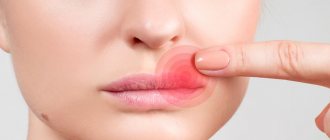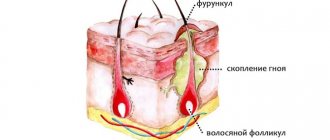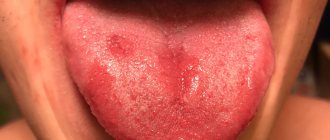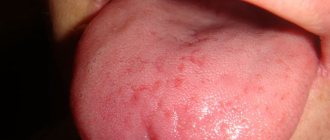Cheilitis is an inflammation of the red border, mucous membrane and skin of the lips. In common parlance, the disease is called jamming. The inflammatory process can be long-lasting and periodically worsen. In healthy young people it often goes away on its own, but in children, the elderly and people with chronic diseases it should be treated with medication. Elderly people have a high risk of leukoplakia and malignancy of the process.
Cheilitis is treated by a dentist, and if necessary, a therapist, pediatrician and other specialized specialists - an endocrinologist, an infectious disease specialist, etc. - are involved in drawing up a treatment plan.
Reasons for the development of cheilitis
The main causes of the disease include:
- Dermatoses seem to be the most common cause of cheilitis. Skin diseases such as psoriasis, lupus erythematosus, syphilis, tuberculosis, lichen, also often provoke inflammation of the red border of the lips.
- Thyroid diseases.
- Allergies to various kinds of external factors, professional activities.
- Adverse weather conditions.
- Hereditary predisposition.
- Decreased immunity, gastrointestinal diseases.
Diagnosis of cheilitis
There are no specific laboratory tests to detect cheilitis. All diagnosis of the disease is carried out by visual examination. To determine the causes of inflammation, diagnostics of the gastrointestinal tract may be prescribed for the presence of Crohn's disease or ulcerative colitis. Additionally, allergy tests are performed to exclude food allergies.
General laboratory tests allow you to check the condition of the body and determine the possible causes of cheilitis:
- low levels of vitamins due to hypovitaminosis can provoke exfoliative cheilitis;
- bacterial cultures of smears and biopsies are performed in patients with immune system disorders in the absence of results from the treatment;
- testing for markers of HIV infection, herpes, the presence of fungal or bacterial microflora, respectively, allows us to identify the viral, bacterial or fungal causative agent of cheilitis;
- a blood test for anemia, ESR are required to assess general health;
- examination of the function of the thyroid and pancreas for endocrine pathologies.
On a note! Cheilitis tends to be chronic with periodic relapses. Self-healing without medical supervision is almost impossible, so try to pay attention to such a “minor” problem and consult a specialist. Diagnosis of the disease is carried out by a general practitioner or attending dentist. In some cases, consultation with an allergist, infectious diseases specialist, dermatovenerologist or gastroenterologist may be required.
Types of cheilitis
All types of cheilitis are divided into two groups:
- symptomatic (cheilitis, as a manifestation of the underlying disease);
- true (as an independent disease).
Types of symptomatic cheilitis and their clinical manifestations
The symptomatic group includes the following types of cheilitis:
- Eczematous - develops against the background of eczema, characterized by redness, swelling, burning and pathological changes in the skin of the lips. If left untreated, it becomes chronic.
- Macrocheilitis - this form of cheilitis is considered a component of Melkersson-Rossolimo-Rosenthal syndrome. There is severe itching and swelling of not only the lip, but also other parts of the face.
- Atopic - a predisposition to allergies to medications and food is a prerequisite for the development of inflammation. It manifests itself as peeling, redness, itching of the skin of the lips, and the formation of cracks in the corners of the mouth.
Prevention of cheilitis
If you would like to avoid such a problem as cheilitis on the lips, never forget about basic preventive measures:
- visit your dentist and therapist for a preventive examination at least 2 times a year;
- Get tested periodically to monitor your health;
- Maintain oral hygiene regularly;
- for excessive dryness of the skin of the lips, use ointments and special hygienic lipsticks several times a day (after meals and also before bedtime);
- use softening lip masks several times a day;
- take vitamins and watch your diet (with a lack of vitamins, some forms of cheilitis can develop);
- If any damage to the skin or mucous membranes of the lips is detected, consult a doctor,
- temporarily avoid consuming acidic foods and drinks, as well as other ingredients that may irritate damaged areas of the skin;
- treat erosions and ulcers in a timely manner when they are first identified, but always consult a doctor before using any anti-cheilitis ointment, medication or paste.
Types of true cheilitis
True cheilitis includes:
- Contact - manifests itself as a result of the body’s reaction to contact with an irritant: cosmetics (determined mainly in women), the bad habit of holding a pen or pencil in the mouth, professional activity (musicians due to prolonged use of the mouthpiece of a wind instrument) Characterized by redness, itching, feeling burning, swelling of the lips.
- Actinic - involves the development of an inflammatory process as a result of special sensitivity to natural phenomena: sunlight, wind, frost, radiation. It manifests itself as small blisters or erosion, swelling of the red border. This type of cheilitis is also called meteorological.
- Exfoliative - occurs mainly in women. The development of pathology occurs against the background of depression, anxiety, and various disorders of the nervous system. The main symptoms are dryness, severe, prolonged peeling of the lip border. Exfoliative cheilitis has two forms: dry and exudative. With exudative inflammation, crusts form, causing pain in the patient.
- Glandular - occurs against the background of hypertrophy of the minor salivary glands. This phenomenon can be congenital (appears after puberty) or acquired as a result of chronic inflammation. There is a risk of suffering from glandular cheilitis in people with periodontal disease, numerous carious cavities, after lupus erythematosus, and leukoplakia. It is initially characterized by increased dryness, which does not disappear with the use of hygiene products. Later - the presence of cracks due to the constant exposure of saliva to the red border of the lips. 20-30% of patients with glandular cheilitis develop squamous cell carcinoma. It is necessary to take a responsible approach to the treatment of this disease and seek qualified help from doctors in a timely manner - surgical intervention may be required.
What causes cheilitis on the lips?
Being a benign inflammatory disease, cheilitis can occur under the influence of certain provoking factors:
- penetration of infection into wounds , microcracks and other types of open damage to the skin of the lips;
- adverse effects of the environment on the face and skin of the lips (wind, snow, sun, temperature changes, frequent contact with chlorinated water, etc.);
- regular use of lipstick and other low-quality decorative or skincare cosmetics containing harmful substances;
- frequent consumption of drinks with a high level of acidity , which can irritate the skin of the lips;
- an individual tendency to hypersensitivity of the skin of the lips or an individual allergic reaction to certain irritating agents (for example, fresh orange juice, honey, certain chemicals, etc.).
Symptoms of cheilitis
When diagnosing cheilitis, the doctor detects the affected areas of the red border of the lips. Lesions can manifest themselves in different forms and, in the absence of timely treatment, gradually move to other areas (the internal mucosa of the mouth and gums). Symptoms of cheilitis can have varying degrees of expression, but in all cases it is necessary to consult a doctor.
Features of the symptoms of this disease may differ, as they always depend on the etiology (origin) of cheilitis and its variety. Here only generalized symptoms and features of this disease will be named:
- redness of the entire surface of the skin and mucous membranes of the lips;
- loss of protection of the stratum corneum of the lips;
- the red border of the lips is usually visible only at their corners;
- loss of healthy color of the mucous membrane;
- wrinkles, cracks, wounds, ulcers on the lips;
- swelling of the lips;
- bleeding;
- peeling, itching, pain in the area where ulcers and cracks are located.
Classification of cheilitis and features of the manifestation of its varieties
Depending on the cause of the development of the disease, cheilitis is classified by doctors and divided into several main types:
| Type of cheilitis | Symptoms | Features and provoking factors |
| Grandular cheilitis |
|
|
| Actinic cheilitis |
|
|
| Allergic cheilitis |
|
|
| Exfoliative cheilitis |
|
|
| Atopic cheilitis |
|
|
| Candidal cheilitis |
|
|
| Eczematous cheilitis |
|
|
| Angular cheilitis |
|
|
To understand how to treat cheilitis, you need to determine the type of disease. But it is difficult to independently assess the degree and type based on symptoms, so it is better to refuse self-medication and trust a specialist. Treatment will depend on these factors.
Diagnosis of cheilitis
Due to the fact that cheilitis can be not only an independent disease, but also a sign of other ailments or pathological systemic disorders, the patient often has to consult different specialists (dentist, dermatologist, endocrinologist, venereologist, oncologist, therapist, etc.).
The patient may also be asked to undergo general tests, tests for hormones and identification of inflammatory and infectious diseases in the body.
Diagnostics is based on the following types of mandatory and optional tests:
- taking anamnesis;
- medical checkup;
- general tests;
- tests to determine hormonal status;
- ultrasound diagnostics;
- pathohistological examination of the salivary glands;
- dermatological scraping to determine infection in a laboratory setting.
How to treat cheilitis?
There are no universal treatment formulas for all diseases. When determining the treatment method, the doctor must rely on the diagnostic results, and also choose the method of therapy that is suitable for the patient according to individual indications.
Treatment of cheilitis will depend on many decisive factors:
- forms of the disease (acute or chronic),
- varieties (for example, atopic cheilitis),
- the reasons for its development (candida fungus, allergy to an irritating agent, etc.),
- degree of severity (mild symptoms, severe symptoms with progression of cheilitis and prolonged absence of treatment).
Let's consider the main methods of therapy for this disease (do not forget that before using one of them you should always first consult with specialists):
- Atopic cheilitis is treated first of all by eliminating the irritant; the doctor may also recommend dietary adjustments and antiallergic therapy, which will help suppress the symptoms with which cheilitis manifests itself. The ointment can also be an addition to general therapy.
- Grandular cheilitis is treated with anti-inflammatory drugs. For this type of cheilitis, ointments, electrocoagulation, and surgical procedures are often prescribed. Medicinal solutions will help avoid the spread of infection or fungi, so experts often recommend specialized rinses, as well as ointments and gels that are applied to the surface of the lips for cheilitis.
- Exfoliative cheilitis can be cured using methods of neuropathology and psychotherapy, hormonal therapy, radiation therapy, laser therapy. It is also recommended to regularly use a softening hygienic lipstick to eliminate signs of severe dryness of the red border of the lips. Often, the doctor prescribes medicinal rinses for the entire oral cavity.
- Actinic cheilitis , which usually develops after prolonged negative exposure to climatic factors (wind, solar ultraviolet radiation, cold and changes in external temperatures), is treated with special ointments with hormones. However, to protect your skin from ultraviolet radiation, it is recommended to use sunscreen or lip balm.
- Candidal cheilitis can be cured fairly quickly if you purchase an antifungal drug prescribed by a doctor. However, the therapeutic effect must be constantly maintained using special ointments such as clotrimazole, as well as daily rinses of the mouth using medicinal solutions. The fungus can reactivate at any time when the immune system weakens.
- Allergic cheilitis requires elimination of the irritant to which the patient has an allergic reaction. After this, you will need to undergo a course of treatment for cheilitis using antiallergic medications.
- Eczematous cheilitis should be treated using sedative and desensitizing drugs. At the same time, it is advisable to make some changes in your daily diet for a while.
Surgical treatment is used for cheilitis quite rarely. As a rule, the need for surgery arises only when serious complications of the disease appear. For example, with some of its varieties, a rough erosive crust forms on the surface of the skin of the lips, which is difficult to remove mechanically (and unsafe).
The doctor will help restore the mucous membrane of the lips, make the skin soft and elastic again, restore its healthy color and cure the disease. The operation may involve removing the crust that has formed, but the procedure can be quite painful and require some time for postoperative rehabilitation. After the operation, you will need to follow all the doctor’s instructions, make special compresses, apply medicinal ointments against complications of cheilitis, etc.
Treatment of cheilitis
This disease requires special treatment, depending on the cause, type and degree of the inflammatory process. The main methods of treating cheilitis:
- local treatment of the surface of the skin of the lips with disinfectant solutions, ointments, vitamin oil solutions;
- physiotherapeutic methods: Bucca radiation, ultrasound, laser therapy;
- a course of vitamin therapy;
- rinsing the mouth with decoctions of medicinal herbs.
If necessary, to eliminate the causes of the disease, specialized specialists may be involved: a dermatologist, an allergist, an infectious disease specialist.
Eczematous cheilitis
Eczematous cheilitis manifests itself under the influence of allergic factors. Most often it happens for cosmetics. Predisposing factors include chronic lip injury and a lack of B vitamins.
Manifestations: Congestive hyperemia, infiltration, the presence of fever-like elements are observed, and seizures may also occur in the corners of the mouth. The lips are covered with crusts. The skin around the lips also suffers, it becomes wet, it peels and burns.
Treatment: All treatment is based on antiseptic treatment of the lips, taking multivitamins, as well as the use of corticosteroid ointments. And first of all, it is natural to eliminate unfavorable factors, that is, the causes.
Allergic cheilitis
A disease that develops in allergy sufferers upon contact with an allergen and affects the surface of the lips. Typical manifestations of this type of cheilitis are a feeling of itching and burning on the lips, dryness and significant discomfort. The lips begin to dry and peel, and the scales of dead epithelium begin to flake off.
The main cause of this disease is the patient’s increased sensitivity to external irritants, in particular to allergens. Allergic, or, as it is also called, contact cheilitis can develop gradually.
It all depends on the patient’s personal sensitivity to allergens, and it can develop over several weeks, months and even years. The duration of this process is determined by the peculiarities of the endocrine system, as well as the degree of manifestation of allergic reactions.
This disease practically does not appear in children. According to statistics, most patients with allergic cheilitis are women over twenty years of age.
Causes of the disease
In most cases, allergic cheilitis is caused by contact allergic irritants. Among the most common allergens that cause cheilitis is lipstick. It is not the lipstick itself that is dangerous, but the substances it contains - rhodamine, eosin and others. Provoking factors also include low-quality dental implants and plastic dentures.
Allergic manifestations may appear after contact with citrus fruits, as well as in patients who have the habit of chewing pencils or pens. The disease is also common for those whose work involves playing wind instruments or hazardous chemical production.
Symptoms of the disease
The disease manifests itself as hyperemia and swelling of the lips, as well as a sensation of itching and burning, accompanied by the formation of erythema. Small painful blisters appear and burst on the affected areas of the lips. If the pathogenic process is prolonged, over time, small scars and scars will form in their place on the lips. Dry lips only increase over time.
Inflammation almost never extends beyond the red border around the lips. In rare cases, it may spread to adjacent skin. Sometimes the inflammatory process moves to the oral mucosa. This form of allergic cheilitis is characterized by hyperemia (significant redness of the tissues), the appearance of noticeable swelling of the tissues, and when trying to palpate, pain occurs.
Diagnosis and treatment
Diagnosis of the disease is carried out by a dentist together with an allergist. To determine the allergen, it is necessary to conduct allergy tests.
When making a diagnosis, it is important to distinguish allergic and atopic cheilitis, as well as exclude exfoliative and actinic cheilitis. Treatment of this disease includes the mandatory elimination of the irritant or allergen that caused it.
Systemic (general) and topical (local) drug therapy is used. General therapy refers to the use of medications taken orally. To relieve allergy symptoms, a course of antihistamines is used. If the case is sufficiently complex, the use of corticosteroids may be indicated. In addition, calcium supplements may be prescribed.
Local treatment of allergic cheilitis includes the use of a variety of emollient oils, ointments and balms based on sea buckthorn, vitamin E and others. To avoid the recurrence of the pathology, it is necessary to take an allergy test in order to eliminate any contact with the allergen in the future. It is also advisable to reconsider your diet and carefully consider the choice of cosmetics.
Glandular cheilitis
A less “pleasant” manifestation, characterized by inflammation of the mucous glands of the lips.
Causes:
- Injuries,
- Bad habits,
- Infection, most often with viruses.
Manifestations: As a result of inflammation, so-called hyperplasia of the labial glands occurs. There is a discharge of purulent secretion. Lips are enlarged. And the most unpleasant thing is that after the inflammation subsides, cystic changes form in the cavity of the glands. As a result, the lips do not restore their previous shape.
Treatment of glandular cheilitis must be carried out under the supervision of a doctor. The patient himself, at home, can only do antiseptic lip baths. And the main treatment should be carried out on an outpatient basis by a dentist.
Division by nature of manifestations
In medical practice, there are many different forms of the pathology in question, many of which are graded according to the characteristics of their pathological manifestations. The most common cases are described below.
Angular form
This type of pathology is also popularly called “jamming.” Depending on the pathogen, angulitis can be candidal (infection of the epithelium by fungi of the genus Candida) or streptococcal (inflammation caused by streptococci). Develops with vitamin deficiency, in the presence of HIV infection, diabetes, and caries in the body. Also, provoking factors can be the habit of biting nails, soaking the epithelium due to frequent licking.
Angular form
Catarrhal form
One of the most common forms, as it occurs as a result of mechanical damage, abrasions, scratches and bacterial infection. Its appearance is also provoked by frequent wetting of the red border with salivary fluid, as well as exposure to excessively hot, humid or dry air. The problem manifests itself as hyperemia and severe swelling. In some cases, slight peeling of the epithelium is observed. The phenomenon can be either infectious or non-infectious in nature.
Catarrhal form
Eczematous form
The disease usually occurs due to the body's reaction to allergens (food, cosmetics, medicines, materials used in dentistry for prosthetics or filling teeth). Its main difference is the patient’s history of eczema. In the acute stage, the disease leads to the formation of scales and crusts on the lips, as well as their severe swelling. Patients usually complain of itching and burning. Often the lesion affects areas adjacent to the red border.
Eczematous form
Exfoliative form of cheilitis
Exfoliative cheilitis is more common as a chronic problem affecting the middle of the lips, where the vertical fold is located. It can be triggered by a lack of vitamin B2, decreased immunity, malfunction of the thyroid gland, and mental disorders. Bad habits (smoking or lip biting) are also often triggers. However, the main cause of the problem is considered to be a psycho-emotional disorder - depression, severe emotional shock, constant stress. The inflammatory process affects the red border, scales appear, tightly fused to the underlying tissue. Patients complain of dry epithelium and burning sensation.
Exfoliative form
Granulomatous form (Mischer cheilitis)
This is a lesion of the mucous membrane, which is characterized by severe swelling of the lips. Often the lower part of the skin-muscular fold “suffers” the most. This swelling becomes smaller during one period, but later increases again. In addition, the development of the pathological process is accompanied by the formation of tiny granulomas in the thickness of the soft tissues - it is because of this that the tissues thicken. The etiology of the development of this phenomenon has not been established. There are suggestions that the problem is based on disturbances in the functioning of blood vessels and nerve fibers, as well as infectious infection. However, these are only hypotheses that do not yet have proven facts.
Misher cheilitis










